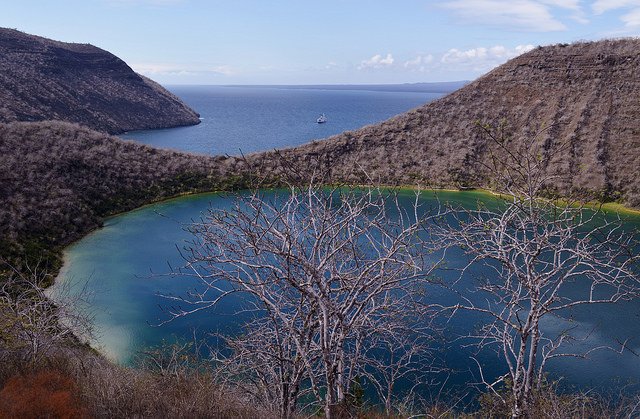Conservation is about protecting that which sustains life on Earth — the rivers that flow with fresh water, the soil rooting crops in place, the forests and marinescapes that release oxygen.
Framed in this way, conservation seems like an undertaking that would be universally supported.
But conservationists face countless challenges, from the industrial forces invested in exploiting natural resources and polluting ecosystems to a general lack of funding and government support. Efforts to conserve an environment have long been framed by opponents as a threat to jobs and community well-being — as if any jobs or well-being would exist without a functioning environment.
This opposition appears to be fading as the climate and biodiversity crisis brings increasing devastation. Organizations are receiving waves of funding, and the voices of Indigenous people, who have long advocated for reciprocity with nature, are being elevated. The United Nations has deemed now until 2030 to be part of the Decade on Restoration, a globally coordinated effort to heal the planet. An increasing number of countries have pledged to protect 30% of land and marine spaces by 2030, and some corporations are beginning to transform their supply chains and operations.
The challenges have never been more daunting. Over the past year, greenhouse gas emissions rebounded to new highs, industrial activities degraded more ecosystems, natural disasters pummeled communities, and various animal and plant species went extinct, grimly underscoring what awaits all wildlife without protection.
At the same time, efforts to heal and safeguard ecosystems proliferated and major conservation goals were advanced. These developments show that the planet can be saved if political courage is mustered.
As we head into a new year of fighting to save the planet, here are five positive conservation narratives — tempered with reality — from the past year.
1. Animals Made Comebacks

In recent decades, wild animal populations have plunged amid habitat loss, climate change, pollution, poaching, and interactions with invasive species. As a result, the sixth mass extinction is well underway. In the US alone, 22 animal species went extinct over the past year.
But there are positive trends happening worldwide. Nepal is on track to double its wild tiger population by 2022, gorilla populations are rebounding in sub-Saharan Africa, and jaguars are returning to forested areas of Colombia. The Iberian lynx has bounced back from near-extinction, a population of endangered monkeys in Vietnam has quadrupled since 2000, and endangered gharials have returned to the Ganges River.
Wolves have surged back to life throughout Europe, a jaguar corridor is under development across the Amazon, and an endangered mountain gazelle made a comeback on the war-torn border of Turkey and Syria. China, meanwhile, is creating a national park to guard giant pandas, which have finally been removed from the endangered species list, and seven Tasmanian devil babies were born in semi-wild conditions for the first time in 3,000 years.
A restored island in the US became an abundant breeding ground for various threatened bird species, while removing invasive predators from a French Polynesian island allowed endangered birds to recover.
These recoveries are just a snapshot of the progress that can be made when the lives of animals are fully valued.
Elsewhere, animals are taking their survival into their own trunks. Elephants, long hunted for their tusks, have begun to evolve without tusks — immunizing themselves from ivory-hungry poachers.
2. Communities Were Given More Control Over Their Land

The field of conservation used to be dominated by outside intervention — well-heeled organizations swooping in to cordon off an ecosystem as if with velvet ropes. Now, community involvement is recognized as an indispensable part of any successful conservation effort. And for good reason — when communities are supported in conservation, environments and their inhabitants thrive.
In the Ankeniheny-Zahamena wildlife corridor of Madagascar, Conservation International trained 24 forest patrollers and equipped them with state-of-the-art technology to protect an endangered lemur population. That initial group has gone on to train more than 300 other patrollers and instill a community-wide ethos of animal protection. The income from the work, meanwhile, has helped to alleviate poverty.
A similar effort is underway in Cambodia, where communities have been trained and equipped with resources to protect endangered gibbons.
Giving land back to Indigenous communities is key to protecting the planet. In Peru, part of the Alto Mayo forest was turned over to 70 Indigenous women for protection and management. Since then, the women have cultivated dozens of edible plants and medicinal herbs from the forest and have begun to raise revenue over the past year by selling special teas.
Around Indonesia’s Way Kambas National Park, an entire cottage industry has emerged around the protection of Sumatran rhinos. Locals collect food for the rhinos and raise revenue through rhino-inspired wood carvings and textile design.
In Mombasa, Kenya, the community group Brain Youth Group gathers every morning to care for mangrove nurseries that have been replanted after deforestation. Mangroves protect communities from coastal erosion and storms and provide habitats for countless marine animals. Intent on incorporating the whole community, the Brain Youth Group is also restoring fisheries to help support local fishers.
Community-led mangrove restoration is happening all over the world, protecting coastlines and guarding communities from the hazards of climate change.
3. Major Conservation Commitments Were Made
 Monteverde, Costa Rica.
Monteverde, Costa Rica.
Monteverde, Costa Rica.
The single most effective way to support conservation is through government policy and ongoing government support. After all, governments control what happens in a particular environment and can mobilize resources to adequately protect an area. Over the past year, an increasing number of governments threw their support behind major conservation initiatives.
In particular, more than 100 countries have agreed to the goal of protecting 30% of land and marine spaces by 2030. Colombia has gone above and beyond by declaring it will reach this goal by 2022, and efforts are underway to increase the global protection range to 50% of the planet. At COP26, more than 100 countries agreed to end deforestation and land degradation by 2030 as well.
Major conservation pledges were made outside of COP. Panama promised to double its marine protected areas, Guayana established a law that will protect a forested area twice the size of Singapore, and Mozambique created a massive new national park. In Romania, a national park meant to rival Yellowstone National Park in the United States is being developed, while the US is restoring protection to three national parks, and Brazil is now paying citizens to protect the Amazon rainforest.
4. Funding for Conservation Increased

Protecting and restoring ecosystems takes a lot of money. In fact, the UN reports that funding for these efforts needs to rise to $350 billion by 2030 and then $536 billion by 2050. But focusing on the costs would be misguided. After all, the returns on investment for conservation are estimated to be five-fold, according to National Geographic. Further, natural resources contribute $125 trillion to the global economy annually. In other words, the global environment is the basis of the economy.
And if you step outside the framework of economics, it’s clear that conserving the planet is essential for our very survival.
Both private and public funders are beginning to recognize this and the past year featured significant financial contributions for conservation as a result.
On the private side of things, nine philanthropic organizations committed $5 billion to conservation causes through 2030, Amazon founder Jeff Bezos pledged another $2 billion while attending COP26, the Rob and Melani Walton Foundation gave $100 million to parks in Africa, and actor Leonardo DiCaprio and Re:wild partners set aside $43 million to rehabilitate the Galápagos Islands.
On the public side of things, countries committed $1.7 billion to Indigenous communities and $12 billion to protecting forests at COP26. On the national level, Canada announced $2.3 billion for conservation, the US is spending tens of billions on conservation, and China committed a fresh $232 million to biodiversity.
5. Degraded Ecosystems Recovered
 1t.org supports initiatives to grow and conserve forests in communities around the world.
1t.org supports initiatives to grow and conserve forests in communities around the world.
Only 3% of global land remains intact, largely shielded from destructive human activities, which means that 97% has been degraded. Recovering and restoring these ecosystems is an undertaking of a lifetime and there’s no better time to get started than now.
Already, communities, organizations, and governments are engaged in restoring degraded landscapes around the world. Clear-cut forest in Borneo is being replanted, drained and polluted bogs in Eastern Europe are being regenerated, and blasted coal mines are being turned into carbon sinks in the US. In Kenya, degraded sources of freshwater are being pumped with new life, while desiccated grasslands in Ontario are being revived as wildlife corridors. The Atlantic Forest in Brazil, meanwhile, is on pace to regenerate 1.5 million hectares of land.
The Bonn Challenge has secured commitments for restoring more than 230 million hectares of land; 1t.org is working to conserve, restore, and grow 1 trillion trees by 2030; and the Waterkeepers Alliance is defending and restoring water systems around the world.
Wildlife is resilient. When you remove sources of harm, plants, animals, bacteria, fungi, and microorganisms flourish, eventually arriving at harmony. When humans respect this arrangement, they, too, thrive, rewarded with abundant gifts from the earth.
That’s the great task before us — removing harm, becoming stewards, and joining the great web of life once again.
It sounds so simple, but the cries of the natural world have been ignored for centuries. Every whimper from immolating koalas, every crumbling shard of bleached coral reef, every poisoned inch of soil turned to desert — these warnings have been muffled by the global mandate for profit.
The suspected origins of the COVID-19 pandemic offered one of the harshest wake-up calls yet — the brutal trafficking of wild animals and the destruction of their habitats spawned a lethal respiratory infection that continues to plague humanity.
What would it take to turn the corner into a new, healthier tomorrow — one full of vibrant life, bursting with hope? Let's listen to Indigenous people.